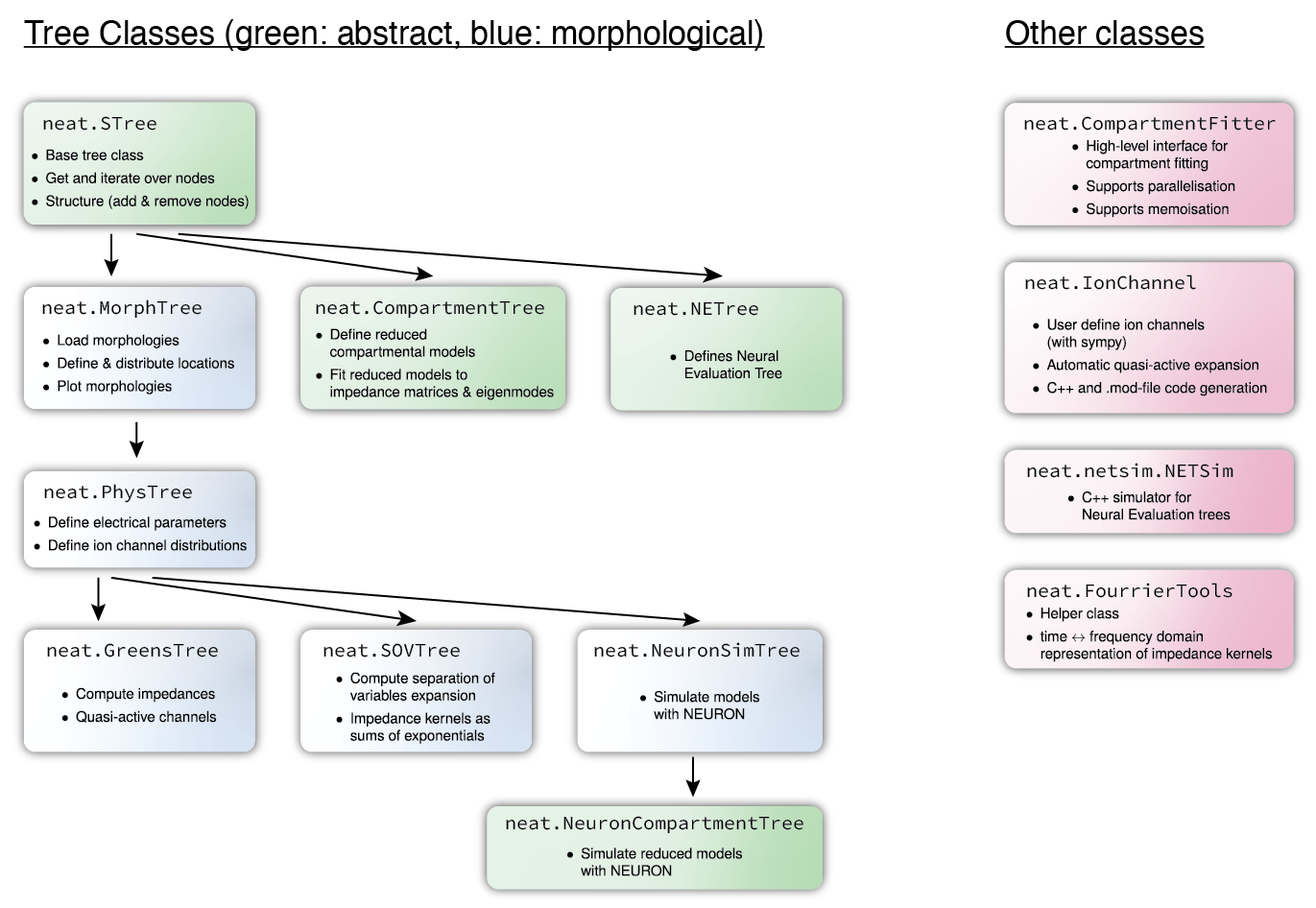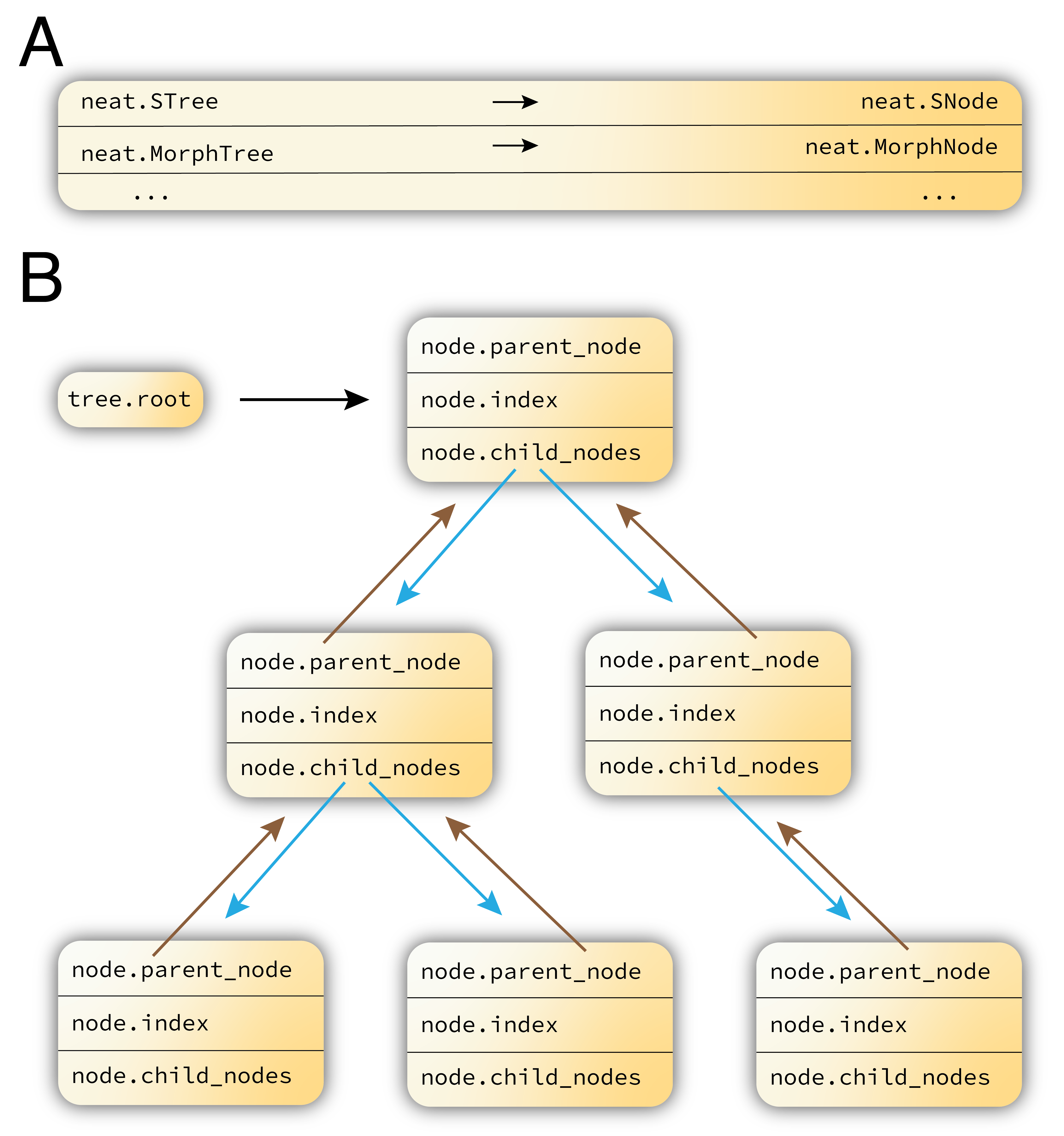Overview of NEAT¶
NEAT is a python library for the study, simulation and simplification of morphological neuron models. NEAT accepts morphologies in the de facto standard .swc format [Cannon1998], and implements high-level tools to interact with and analyze the morphologies.
NEAT also allows for the convenient definition of morphological neuron models. These models can be simulated, through an interface with the NEURON simulator [Carnevale2004], or can be analyzed with two classical methods: (i) the separation of variables method [Major1993] to obtain impedance kernels as a superposition of exponentials and (ii) Koch’s method to compute impedances with linearized ion channels analytically in the frequency domain [Koch1985]. Furthermore, NEAT implements the neural evaluation tree framework [Wybo2019] and an associated C++ simulator, to analyze subunit independence.
Finally, NEAT implements a new and powerful method to simplify morphological neuron models into compartmental models with few compartments [Wybo2020]. For these models, NEAT also provides a NEURON interface so that they can be simulated directly, and will soon also provide a NEST interface [Gewaltig2007].
Structure¶
NEAT’s main functionality is implemented throught a number of tree classes. neat.STree is the base class, implementing basic functionalities such as getting and iterating over nodes, as well as adding and removing nodes. Each class implements another layer of functionality over the class from which it inherits. Figure 1 provides an overview of the inheritance structure. For instance, neat.MorphTree inherits from neat.STree, and implements all functionality to load, store and interact with morphologies. neat.PhysTree then adds another layer of functionality by allowing the definition of electrical parameters.
NEAT furthermore has a number of other classes, notably to implement ion channels (neat.IonChannel) and to provide a high-level API for the simplification method described in [Wybo2021] (neat.CompartmentFitter).

Figure 1. Overview of NEAT structures. NEAT contains a number of tree classes, inheriting from neat.STree, as well as a number of helper classes.¶
A NEAT tree consists of nodes, and each tree class has a corresponding node class
(Figure 2A). A tree class contains a root attribute (Figure 2B), which points to the
corresponding node class instance that is the root of the tree (the soma, if
the tree is a MorphTree or a derived class). Each node has an index (by which
it can be accessed from the tree class), a reference to its parent node (None
if the node is the root), and a list containing references to its child nodes
(empty if the node is a leaf).

Figure 2. Layout of a NEAT tree. A: Each NEAT tree consists of corresponding nodes. B: A tree contains a root node attribute, and each node has a parent node, an index and a list of child nodes.¶
Audience¶
NEAT is of interest to neuroscientist who aim to understand dendritic computation, and to explore dendritic computation at the network level.
Python¶
Python is a powerful programming language that allows simple and flexible representations neural morphologies. Python has a vibrant and growing ecosystem of packages that NEAT uses to provide more features such as numerical linear algebra and drawing. In order to make the most out of NEAT you will want to know how to write basic programs in Python. Among the many guides to Python, we recommend the Python documentation and the text by Alex Martelli [Martelli03].
Free software¶
NEAT is free software; you can redistribute it and/or modify it under the terms of the GNU General Public License. We welcome contributions. Join us on GitHub.
History¶
NEAT was born in April 2018. The original version was designed and written by Willem Wybo, based on code by Benjamin Torben-Nielsen. With help of Jakob Jordan and Benjamin Ellenberger, NEAT became an installable python package with documentation website.
Contributors are listed in credits.
Documentation¶
- Release
0.9.1
- Date
Mar 25, 2021